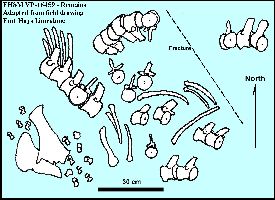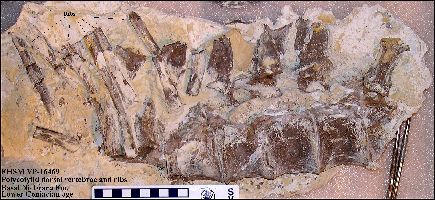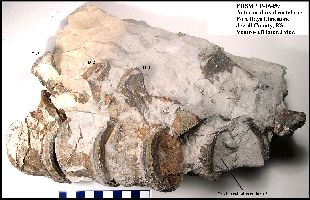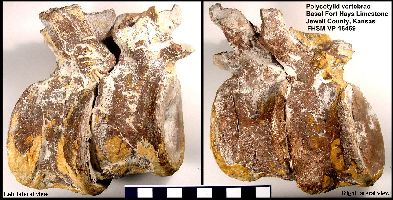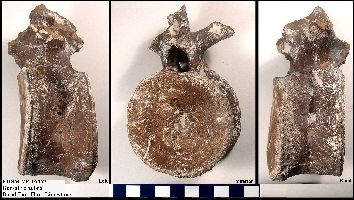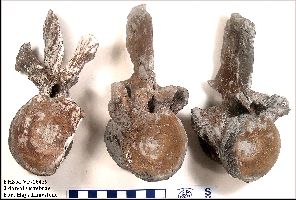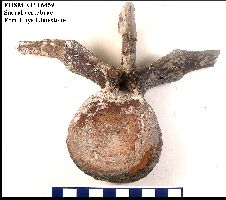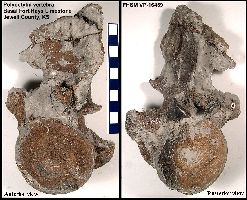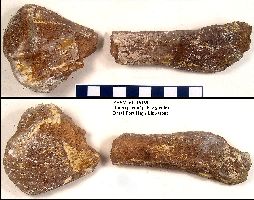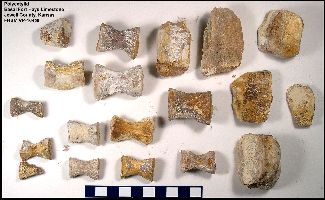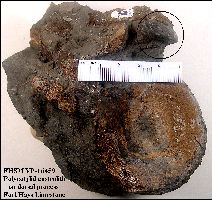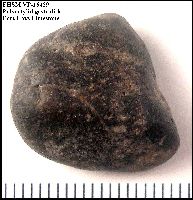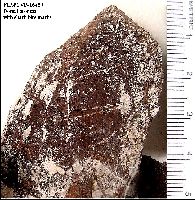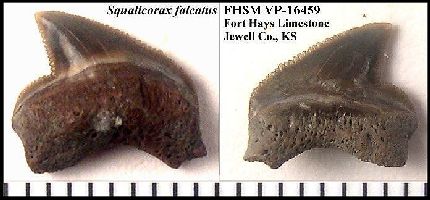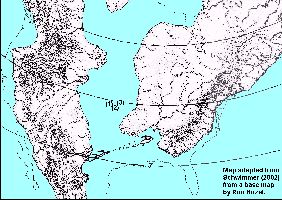 |
FHSM VP-16459
First polycotylid remains
from the Fort Hays Limestone
Copyright © 2009 by Mike Everhart
Created 02/09/2009 - Updated 09/18/2009
RIGHT: Dolichorhynchops osborni;
Adapted from an original pen and ink drawing by Russell Hawley, used with
permission. |
In September, 2005, while on a weekend hunt for sharks
teeth, Ramo and Pam Decker discovered large plesiosaur bones exposed at the edge of the
quarry on the surface of the basal Fort Hays Limestone Member of the Niobrara
Formation. The bones had been uncovered by machinery that ground up the limestone
for roadbed material. Part of the specimen had already been lost and the rest would be
destroyed with the next pass of the machine. Over the next two weeks, the Deckers were
able to safely collect the remains. When they contacted me, I was amazed to learn of the
discovery. It had been well over a hundred years since a plesiosaur had been found in the
Fort Hays Limestone (coincidentally, about 15 miles south near the town of Jewell, in
Jewell County), and few people since had actively collected from that rock unit. Here is a
quote from Prof. B.F. Mudge, 1876, regarding this area and the
long necked plesiosaur (YPM
1640 - "Elasmosaurus nobilis" Williston 1906) that he collected
there:
“Its
fossils are Inocerami, fragments of Haploscapha [rudists], Ostrea,
with occasional remains of fish and Saurians. The vertebrates are so rare that we never wasted our time in hunting them in this stratum; still,
our largest Saurian, Brimosaurus of Leidy, was found in Jewell County.” B.F. Mudge, 1876 |
Fortunately, they didn't know that they were
"wasting their time" hunting fossils in the Fort Hays Limestone, and were thus
able to show me not only the polycotylid plesiosaur specimen, but the other specimens of
bony fish and shark teeth that they had collected from the surrounding area. They were
also generous in donating the polycotylid specimen to the Sternberg Museum where it is
curated as FHSM VP-16459. We presented a paper at the 2006 Annual Meeting of the Kansas
Academy of Science:
*Everhart, M.J., Sternberg Museum of Natural
History, R. Decker and P. Decker, Mankato, Kansas. 2006.
EARLIEST REMAINS OF DOLICHORHYNCHOPS OSBORNI (PLESIOSAURIA: POLYCOTYLIDAE) FROM THE
BASAL FORT HAYS LIMESTONE, JEWELL COUNTY, KANSAS.
The Fort Hays Limestone Member of the Niobrara Chalk was deposited
in the Western Interior Sea during the maximum transgressive phase of the Niobrara
Cyclothem (early Coniacian). The water was relatively deep, well-aerated and far enough
from shore as to be beyond the influence of terrestrial sediments. The member ranges from
17-24 m in thickness and consists of several relatively resistant beds of chalky limestone
separated by thin layers of chalky shale. Although rich in invertebrate remains, the Fort
Hays has produced few vertebrate specimens. In 2005, polycotylid plesiosaur (Dolichorhynchops
osborni) remains were collected from the basal Fort Hays in Jewell County, Kansas. The
specimen (FHSM VP-16459) consists of a semi-articulated series of 24 dorsal vertebrae,
pelvic and pectoral girdle fragments, ribs, and distal limb elements. Dolichorhynchops
was previously known from the Campanian age Smoky Hill Chalk and Pierre Shale, although
fragmentary remains of polycotylids have been reported from the upper Coniacian. The new
specimen is only the second plesiosaur and the third marine reptile collected from the
Fort Hays. Remains of Xiphactinus, Cimolichthys, Protosphyraena and
several species of shark teeth have been collected by the authors from the same
stratigraphic level. The new specimen significantly extends the temporal range of Dolichorhynchops
and adds to our knowledge of the faunal diversity of the Western Interior Sea during early
Coniacian time. |
FHSM VP-16459 - Features:
> The remains represent an adult polycotylid, slightly larger
than KUVP 1300 or FHSM VP-404, based on the size of the vertebrae.
> Almost all of the dorsal vertebrae present, including 1 or
more sacrals, and a posterior cervical.
> No cranial material present
> Most of the vertebrae were found in articulation.
> The centra of the larger vertebrae are about 7 cm in
diameter, and 4-5 cm in length
> Elements of pectoral and pelvic girdles present (damaged);
many ribs and fragments of bone
> Distal elements of at least one paddle present
> One gastrolith was found in contact with a dorsal vertebra
> Some evidence of scavenging is present (bite marks / shark
tooth)
> A portion of the remains were briefly colonized by oysters
before burial
Since then, with some gentle reminders from Bruce Schumacher, I have come to
realize the specimen does not contain sufficient diagnostic features to actually identify
it as Dolichorhynchops osborni (or Trinacromerum bentonianum). The last Trinacromerum
remains occur in the Fairport Chalk (Middle Turonian - See Schumacher and Everhart,
2005)... and the first identifiable Dolichorhynchops remains occur in the early
Campanian (Carpenter, 1996; Everhart, 2003)... leaving a gap of over 6 million years where
no species of polycotylid has ever been positively identified from the Western Interior
Sea.
In 2003, I described some very fragmentary, partially digested plesiosaur remains from the lower
Smoky Hill Chalk (Late Coniacian) that were "probably" Dolichorhynchops,
but did not exhibit any good diagnostic features. Based on the characteristics of the
vertebrae of FHSM VP-16459, I could say with some confidence that the remains were NOT
from Polycotylus latipinnis Cope 1869... the first polycotylid described from the
Smoky Hill Chalk. What I cannot do is distinguish FHSM VP-16459 from Trinacromerum
on the basis of the remaining vertebrae or limb elements. Most likely it is Dolichorhynchops,
possibly an earlier form, but for now I have to identify it as something that looks
like (cf.) Dolichorhynchops. Additional specimens would be helpful as would a
better definition of the post-cranial differences between the various species. So
many fossils, so little time....
Here's a photographic summary of what we have recovered and prepared to date
for FHSM VP-16459:
Preliminary faunal list - Jewell County
Basal Fort Hays Limestone
Codell Sandstone
(Early Coniacian ~ 89 mya)
(Middle Turonian ~ 91 mya)
Elasmosaurid (Mudge, 1874)
Mosasaurs (Tylosaurus sp.?)
cf. Dolichorhynchops
sp. (Decker, 2005)
Hadrodus sp.
Xiphactinus audax
Albulidae indet.
Cimolichthys nepaholica
Protosphyraena cf. perniciosa
Enchodus petrosus
SHARKS:
Cretoxyrhina mantelli
Cretoxyrhina
mantelli
Squalicorax falcatus
Squalicorax
falcatus
Cretodus sp.
Cretalamna appendiculata
Cardabiodon sp.
Hybodus sp.
Scapanorhynchus raphiodon
Ischyrhiza mira
Ptychodus whipplei
REFERENCES:
Carpenter, K. 1996. A Review of short-necked plesiosaurs from the
Cretaceous of the western interior, North America. Neues Jahrbuch fuer Geologie und
Palaeontologie Abhandlungen (Stuttgart) 201(2):259-287.
Cope, E. D. 1869. [Remarks on fossil reptiles, Clidastes propython, Polycotylus
latipinnis, Ornithotarsus immanis.]. Proceedings of the American Philosophical
Society xi p. 117. (meeting of June 18, 1869)
Cragin, F. W. 1888. Preliminary description of a new or little known saurian from
the Benton of Kansas, American Geologist 2:404-407.
Everhart, M. J. 2003. First
records of plesiosaur remains in the lower Smoky Hill Chalk Member (Upper Coniacian) of
the Niobrara Formation in western Kansas. Kansas Academy of Science, Transactions
106(3-4):139-148.
Everhart, Michael J. 2005. Oceans of Kansas - A Natural History of the
Western Interior Sea. Indiana University Press, 320 pp. ISBN: 0253345472
Everhart, M. J. 2007. Sea Monsters: Prehistoric Creatures of the Deep.
National Geographic, 192 p.ISBN-13:978-1426200854
Everhart, M.J., R. Decker and P. Decker. 2006. Earliest remains of Dolichorhynchops
osborni (Plesiosauria: Polycotylidae) from the basal Fort Hays Limestone, Jewell
County, Kansas. Abstracts from the 138th> Annual Meeting, Kansas Academy of Science,
Transactions 109(3-4):251.
Mudge, B. F. 1876. Notes on the Tertiary and Cretaceous periods of Kansas.
Bulletin U.S. Geological Survey Territories (Hayden), 2(3):211-221.
O'Keefe, F. R. 2008. Cranial anatomy and taxonomy of Dolichorhynchops
bonneri new combination, a polycotylid plesiosaur from the Pierre Shale of Wyoming
and South Dakota. Journal of Vertebrate Paleontology 28(3): 664-676.
Schmeisser,
R.L. and Gillette, D.D. 2009. Unusual occurrence
of gastroliths in a polycotylid plesiosaur from the Upper Cretaceous Tropic Shale,
southern Utah. PALAIOS 2009 24: 453-459.
Schumacher, B. A. and M. J. Everhart. 2005. A stratigraphic and taxonomic review of
plesiosaurs from the old “Fort Benton Group” of central Kansas: A new assessment
of old records. Paludicola 5(2):33-54.
Sternberg, G. F. and M. V. Walker. 1957. Report on a plesiosaur skeleton from
western Kansas. Kansas Academy of Science, Transactions, 60(1):86-87.
Williston, S. W. 1902. Restoration of Dolichorhynchops osborni,
a new Cretaceous plesiosaur. Kansas University Science Bulletin, 1(9):241-244, 1 plate.
Williston, S. W. 1908. North American plesiosaurs: Trinacromerum.
Journal of Geology 16:715-735. figs. 1-15.

BACK TO
OCEANS OF KANSAS PALEONTOLOGY MAIN PAGE

